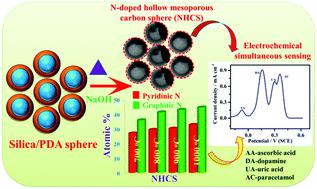当前位置:
X-MOL 学术
›
New J. Chem.
›
论文详情
Our official English website, www.x-mol.net, welcomes your feedback! (Note: you will need to create a separate account there.)
Ultrasensitive simultaneous detection of ascorbic acid, dopamine, uric acid and acetaminophen on a graphitized porous carbon-modified electrode
New Journal of Chemistry ( IF 3.3 ) Pub Date : 2020-12-9 , DOI: 10.1039/d0nj04806b Velu Duraisamy 1, 2, 3, 4, 5 , Velayutham Sudha 1, 2, 3, 4, 5 , Kuppusamy Annadurai 1, 2, 3, 4, 5 , Sakkarapalayam Murugesan Senthil Kumar 1, 2, 3, 4, 5 , Rangasamy Thangamuthu 1, 2, 3, 4, 5
New Journal of Chemistry ( IF 3.3 ) Pub Date : 2020-12-9 , DOI: 10.1039/d0nj04806b Velu Duraisamy 1, 2, 3, 4, 5 , Velayutham Sudha 1, 2, 3, 4, 5 , Kuppusamy Annadurai 1, 2, 3, 4, 5 , Sakkarapalayam Murugesan Senthil Kumar 1, 2, 3, 4, 5 , Rangasamy Thangamuthu 1, 2, 3, 4, 5
Affiliation

|
The development of active and defective sites containing mesoporous carbon material is highly crucial for high-performance sensors. In this work, N-doped hollow carbon sphere (NHCS) materials with high surface area and large volume of graphitic and pyridinic N were obtained by variation of the carbonization temperature between 700–1000 °C. Here, dopamine hydrochloride and tetraethyl orthosilicate (TEOS) were used as C, N and silica precursors, with both involved in silica-poly (dopamine) (PDA) sphere formation followed by silica etching to NHCS. Among NHCS materials, NHCS-1000 exhibited an improved surface area, porosity, layer thickness, defective sites and graphitic along with pyridinic sites. An NHCS-modified glassy carbon electrode (NHCS/GCE) was fabricated and successfully used for the simultaneous sensing of ascorbic acid (AA), uric acid (UA), dopamine (DA) and acetaminophen (AC). All NHCS materials exhibited electrocatalytic activity towards the oxidation of these four biologically important analytes. Compared with other carbon materials, NHCS-1000 showed a higher electrocatalytic activity. Hence, the NHCS-1000-modified electrode was used for the further electrochemical sensing of multiple analytes. The limit of detection (LOD) values were 0.135, 0.012, 0.131 and 0.095 μM, respectively, for AA, UA, DA and AC. From the calibration plot, the calculated sensitivity values were: 0.029 mA cm−2 mM−1 for AA, 0.73 mA cm−2 mM−1 for DA, (0.53; 0.069 mA cm−2 mM−1) for UA, and (0.53; 0.765 mA cm−2 mM−1) for AC. The linear ranges of AA, DA, UA and AC were 0.01–7.0 mM, 0.001–1.5 mM, (0.005–1.0; 2.0–6.0 mM), and (0.05–1.0; 2.0–6.0 mM), respectively. The NHCS-1000-modified electrode showed good selectivity and linear range. The proposed NHCS-1000/GCE was effectively used for the detection of multiple analytes in the real samples of urine, serum, ascorbic acid and commercially available tablets.
中文翻译:

石墨化多孔碳修饰电极上抗坏血酸,多巴胺,尿酸和对乙酰氨基酚的超灵敏同时检测
含有介孔碳材料的活性部位和缺陷部位的发展对于高性能传感器至关重要。在这项工作中,通过在700–1000°C之间变化碳化温度,获得了具有高表面积,大量石墨和吡啶二氮的N掺杂空心碳球(NHCS)材料。在此,将多巴胺盐酸盐和原硅酸四乙酯(C)和C的前驱体用作二氧化硅和二氧化硅的前体,两者均参与二氧化硅-聚(多巴胺)(PDA)球的形成,然后将二氧化硅蚀刻成NHCS。在NHCS材料中,NHCS-1000的表面积,孔隙率,层厚,缺陷部位和石墨部位以及吡啶鎓部位均得到改善。制作了NHCS修饰的玻碳电极(NHCS / GCE),并将其成功用于同时检测抗坏血酸(AA),尿酸(UA),多巴胺(DA)和对乙酰氨基酚(AC)。所有NHCS材料对这四种生物学上重要的分析物的氧化均表现出电催化活性。与其他碳材料相比,NHCS-1000具有更高的电催化活性。因此,将NHCS-1000修饰的电极用于多种分析物的进一步电化学检测。对于AA,UA,DA和AC,检测下限(LOD)值分别为0.135、0.012、0.131和0.095μM。根据校准曲线,计算出的灵敏度值为:0.029 mA cm NHCS-1000修饰电极用于多种分析物的进一步电化学传感。对于AA,UA,DA和AC,检测下限(LOD)值分别为0.135、0.012、0.131和0.095μM。根据校准曲线,计算出的灵敏度值为:0.029 mA cm NHCS-1000修饰电极用于多种分析物的进一步电化学传感。对于AA,UA,DA和AC,检测下限(LOD)值分别为0.135、0.012、0.131和0.095μM。根据校准曲线,计算出的灵敏度值为:0.029 mA cm-2毫-1为AA,0.73毫安厘米-2毫-1为DA,(0.53;0.069毫安厘米-2毫-1),用于UA,和(0.53;0.765毫安厘米-2毫-1),用于AC。AA,DA,UA和AC的线性范围分别为0.01-7.0 mM,0.001-1.5 mM,(0.005-1.0; 2.0-6.0 mM)和(0.05-1.0; 2.0-6.0 mM)。NHCS-1000修饰的电极显示出良好的选择性和线性范围。提出的NHCS-1000 / GCE可有效地用于检测尿液,血清,抗坏血酸和市售片剂的真实样品中的多种分析物。
更新日期:2021-01-12
中文翻译:

石墨化多孔碳修饰电极上抗坏血酸,多巴胺,尿酸和对乙酰氨基酚的超灵敏同时检测
含有介孔碳材料的活性部位和缺陷部位的发展对于高性能传感器至关重要。在这项工作中,通过在700–1000°C之间变化碳化温度,获得了具有高表面积,大量石墨和吡啶二氮的N掺杂空心碳球(NHCS)材料。在此,将多巴胺盐酸盐和原硅酸四乙酯(C)和C的前驱体用作二氧化硅和二氧化硅的前体,两者均参与二氧化硅-聚(多巴胺)(PDA)球的形成,然后将二氧化硅蚀刻成NHCS。在NHCS材料中,NHCS-1000的表面积,孔隙率,层厚,缺陷部位和石墨部位以及吡啶鎓部位均得到改善。制作了NHCS修饰的玻碳电极(NHCS / GCE),并将其成功用于同时检测抗坏血酸(AA),尿酸(UA),多巴胺(DA)和对乙酰氨基酚(AC)。所有NHCS材料对这四种生物学上重要的分析物的氧化均表现出电催化活性。与其他碳材料相比,NHCS-1000具有更高的电催化活性。因此,将NHCS-1000修饰的电极用于多种分析物的进一步电化学检测。对于AA,UA,DA和AC,检测下限(LOD)值分别为0.135、0.012、0.131和0.095μM。根据校准曲线,计算出的灵敏度值为:0.029 mA cm NHCS-1000修饰电极用于多种分析物的进一步电化学传感。对于AA,UA,DA和AC,检测下限(LOD)值分别为0.135、0.012、0.131和0.095μM。根据校准曲线,计算出的灵敏度值为:0.029 mA cm NHCS-1000修饰电极用于多种分析物的进一步电化学传感。对于AA,UA,DA和AC,检测下限(LOD)值分别为0.135、0.012、0.131和0.095μM。根据校准曲线,计算出的灵敏度值为:0.029 mA cm-2毫-1为AA,0.73毫安厘米-2毫-1为DA,(0.53;0.069毫安厘米-2毫-1),用于UA,和(0.53;0.765毫安厘米-2毫-1),用于AC。AA,DA,UA和AC的线性范围分别为0.01-7.0 mM,0.001-1.5 mM,(0.005-1.0; 2.0-6.0 mM)和(0.05-1.0; 2.0-6.0 mM)。NHCS-1000修饰的电极显示出良好的选择性和线性范围。提出的NHCS-1000 / GCE可有效地用于检测尿液,血清,抗坏血酸和市售片剂的真实样品中的多种分析物。



























 京公网安备 11010802027423号
京公网安备 11010802027423号